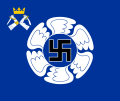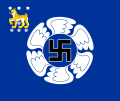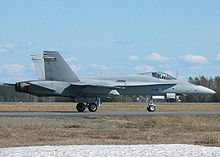Air forces of Finland
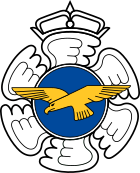
|
|
| Lineup | 1918 |
| Country | Finland |
| Type | Armed forces ( air forces ) |
| insignia | |
|
Aircraft cockade |
|
| current flag of the Finnish Air War School | |
| current flags of the Finnish squadrons | |
The air forces ( Finnish Ilmavoimat , Swedish Luftmakten ) of Finland are a 3100 strong part of the defense forces of Finland . The head office is in Jyväskylä - Tikkakoski . Major General Pasi Jokinen has been the head of the Air Force since April 1, 2019 .
The Finnish Air Force's motto is “Qualitas Potentia Nostra” (Quality is our strength).
history
The history of the Finnish Air Force goes back to February 25, 1918, when the Finnish Army, then fighting Russia , acquired their first aircraft. It was a NAB Albatros that was flown - without permission from Sweden - by the two pilots John-Allan Hygerth and Per Svanbäck via Haparanda and Kokkola to Jakobstad . The aircraft was financed with Swedish donations on the initiative of Waldemar Langlet , editor of Aftonbladet . Hygerth, who sympathized with the Finnish struggle for independence, was appointed commander of the newly created Finnish Air Force four days later, which was then called the Finnish Air Corps . In a similar operation, on March 6, 1918, the Swedish lieutenant Nils Kindberg flew a Thulin D given to the Finnish government by the Swedish nobleman Eric von Rosen to Vaasa .
The few aircraft that were brought to Finland on the private initiative of Swedish sympathizers formed the basis of the Finnish air force, which was officially launched in 1920 with French help (especially with regard to the organization). From 1924, the air forces were modernized and expanded with the help of a British military mission.
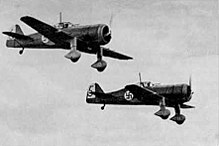

At the beginning of the Finnish-Soviet winter war in November 1939, the Ilmavoimat was able to deploy only 31 fighters and 17 bomber planes in addition to 54 militarily less valuable liaison aircraft against the Soviet invasion . Most of them were Bristol Blenheims and Fokker D.XXI . With around 700 fighters and 800 bombers, the Soviet Union faced a great superior force. Nevertheless, the Finns had great successes in the fight against the Soviets. In order to prevent their aircraft from being destroyed on the ground and to avoid a similar disaster that the Polish air forces suffered during the attack on Germany in 1939 , the Finnish aircraft were stationed in a decentralized manner, some of them in forests. This ensured that the damage from Soviet bombing was minimal. The Finns themselves achieved great success in the air: 218 enemy aircraft were shot down in aerial combat versus 47 losses of their own. The Finnish flak also shot down 314 Soviet planes. In addition, 30 Soviet aircraft were captured intact and incorporated into the Ilmavoimat.
In the Continuation War from June 1941, the Ilmavoimat was better prepared than in 1939, even if the aircraft arsenal was at first glance no longer very modern compared to other air forces. During the Winter War Finland had numerous new aircraft, including a. French Morane-Saulnier MS.406 , British Hawker Hurricanes , Italian Fiat G.50 as well as Curtiss P-36 and Brewster F2A bought from the USA . Now they have been used successfully. The Brewster F2A (339) in particular proved to be surprisingly effective in the hands of the Finns and remained the Ilmavoimat's standard fighter until 1943 when they were replaced by German Messerschmitt Bf 109s . By then they had shot down 496 enemy aircraft with only 19 losses, which corresponds to a kill ratio of 26: 1.
In 1942 the bomber formations with the German Dornier Do 17 and Junkers Ju 88 were modernized, but were comparatively little used. Curiously, the Finnish pilots were even forbidden to fly over Soviet cities and bases - on the one hand to avoid unnecessary provocations, on the other hand to save their own material. Therefore, today it is claimed that the Ilmavoimat did not fall victim to civilians during the entire war.
When an armistice was signed between Finland and the Soviet Union in September 1944. a. provided for extensive demilitarization of the Finnish armed forces, another requirement was the expulsion of all German troops from Finland. Since they refused to leave the country voluntarily, the Continuation War culminated directly in the Lapland War . The Ilmavoimat now fought against their former ally, the German Air Force . These fighting lasted until April 1945.
By the end of all hostilities, the Ilmavoimat had destroyed 1621 Soviet aircraft with 210 losses of its own.
After the Second World War , a peace agreement was signed with the Soviet Union in 1947 that limited the size of the Ilmavoimat. Until the collapse of the Soviet Union , both western and Soviet aircraft (e.g. MiG-21 , Saab 35 Draken , BAE Hawk ) were in use. Since the 1990s, the Soviet types have been increasingly replaced by Western material.
Current equipment
| plane | origin | use | version | active | Stored | Ordered | Remarks |
|---|---|---|---|---|---|---|---|
| Warplanes | |||||||
| McDonnell Douglas F / A-18 Hornet |
|
Multipurpose fighter | F / A-18C | 54 | License construction | ||
| Transport aircraft | |||||||
| CASA C-295 |
|
Tactical transport aircraft | C-295 | 3 | |||
| Fokker F-27 Friendship |
|
Military transporter | F-27 | 2 | |||
| Bombardier Learjet |
|
VIP transportation | Learjet 35 | 3 | |||
| Pilatus PC-12 |
|
VIP transportation | PC-12NG | 6th | |||
| Training planes and helicopters | |||||||
| McDonnell Douglas F / A-18 Hornet |
|
Trainer aircraft | F / A-18D | 7th | License construction | ||
| BAE Hawk |
|
Trainer aircraft | Hawk 51 / 51A / 66 | 42 | 15th | License construction | |
| Aermacchi M-290 RediGO |
|
Trainer aircraft | M-290TP | 9 | |||
As of the end of 2012
18 Hawk machines were acquired from the Swiss Air Force .
Aircraft markings
In the early days of the Finnish Air Force in 1918, General Mannerheim designated a blue swastika on a white background as the national emblem for Finnish aircraft . The sign was affixed to the aircraft a total of six times, on both sides of both wings and on both halves of the fuselage. In the final phase of the Second World War in particular, there was a variant with a blue-gray background. During the Lapland War against the Germans, the national emblem was changed to the current white-blue-white cockade in order to differentiate it more clearly from the German national emblems.
On July 2, 2020, it became known in the media that the Finnish Ministry of Defense had ordered the air force to remove the blue swastika from all uniforms, flags and aircraft. The “golden eagle” used by the air force officially replaces the old symbol.
Web links
Individual evidence
- ↑ a b DER SPIEGEL: After around 100 years: Finnish Air Force removes swastikas from uniforms and aircraft - DER SPIEGEL - Politics. Retrieved July 2, 2020 .
- ↑ World Air Forces 2013 ( English , PDF; 4.0 MB) In: Flightglobal Insight . 2013. Archived from the original on December 16, 2012. Retrieved on April 12, 2013.
- ↑ Symbols - Finland does not use swastikas in the Air Force. Retrieved on July 2, 2020 (German).


